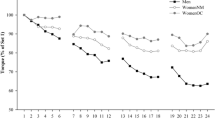Abstract
This study examined if estrogen (E) usage (in the form of hormone replacement therapy (HRT)) has a protective effect on skeletal muscle damage in postmenopausal women. Nine postmenopausal women (age 55.2 ± 9.9 [mean ± SD]) performed two exercise sessions at 70% of their maximal heart rate on HRT (E-HI) and without HRT (E-LO; following a 28–45 day HRT washout). All subjects followed a condition order of E-HI and then E-LO with at least 42 days between exercise sessions. Serum creatine kinase (CK), perceived delayed onset muscle soreness (DOMS), and maximal quadriceps isometric force (MIF) were determined before exercise and 24, 48, and 72 h after exercise. E-HI and E-LO conditions produced a rise in CK (p < 0.001) after exercise, but CK after E-HI was greater than in E-LO (p < 0.001) at 24 and 48 h. DOMS was significantly elevated at 24, 48, and 72 h after each exercise session (p < 0.05). The greatest peak DOMS score occurred during the E-HI condition. MIF was similarly reduced after each exercise session (p < 0.05). These results suggest that elevated E does not offer a protective effect to skeletal muscle; however, design limitations (i.e., condition order) confound the present data. Interestingly, an association between peak CK during the E-LO condition and the number of washout days (r = +0.707, p < 0.05) between conditions existed. This suggests that a longer washout period may be necessary to elucidate the actual effects of E on skeletal muscle. These findings suggest that more work on this topic, correcting for the present design limitations, is warranted.
Similar content being viewed by others
REFERENCES
Roth, S.M., Martel, G.F., Ivey, F.M., et al., High-Volume, Heavy-Resistance Strength Training and Muscle Damage in Young and Older Women, J. Appl. Physiol., 2000, vol. 88, p. 1112.
Amelink, G.J., Koot, R.W., Erich, W.B.M., et al., Sexlinked Variation in Creatine Kinase Release, and Its Dependence on Estradiol, Can Be Demonstrated in an In-VitroRat Skeletal Muscle Preparation, Acta Physiol. Scand., 1990, vol. 138, p. 115.
Carter, A.J., Dobridge, J., and Hackney, A.C., The Effects of Estrogen Status on Muscle Tissue Damage in Women Following an Eccentric Exercise Bout, Hum. Physiol., 2001, vol. 27, no. 5, p. 133.
Komulainen, J., Koskinen, S.O.A., Kalliokoski, R., et al., Gender Differences in Skeletal Muscle Fiber Damage After Eccentrically Biased Downhill Running in Rats, Acta Physiol. Scand., 1999, vol. 165, p. 57.
McCormick, K.M., Byrnes, W.C., Clarkson, P.M., et al., Menstrual Cycle Effects on Exercise-induced Changes in Muscle Soreness, Serum Creatine Kinase and Myoglobin, Med. Sci. Sports Exer., 1983, vol. 17, no. 2, p. 278.
Thompson, H.S., Hyatt, J., De Souza, M.J., and Clarkson, P.M., The Effects or Oral Contraceptives on Delayed Onset Muscle Soreness Following Exercise, Contraception, 1997, vol. 56, p. 59.
Tiidus, P.M., Can Estrogens Diminish Exercise-induced Muscle Damage?, Can. J. Appl. Physiol., 1995, vol. 20, p. 26.
Tietz, N.W., Clinical Guide to Laboratory Tests, Saunders, 1990, 2nd ed.
Byrnes, W.C. and Clarkson, P.M., Delayed Onset Muscle Soreness and Training, Clin. Sport Med., 1986, vol. 5, no. 3, p. 605.
Clarkson, P.M., Nosaka, K., and Braun, B., Muscle Function after Exercise-induced Muscle Damage and Rapid Adaptation, Med. Sci. Sports Exer., 1992, vol. 24, p. 512.
Clarkson, P.M. and Ebbeling, C., Investigation of Serum Creatine Kinase Variability after Muscle-damaging Exercise, Clin. Sci., 1988, vol. 75, no. 3, p. 257.
Horobagyi, T. and Denahan, T., Variability in Creatine Kinase: Methodological, Exercise and Clinically Related Factors, Int. J. Sports Med., 1989, vol. 10, p. 69.
Newham, D.J., Jones, A., Ghosh, G., and Aurora, P., Muscle Fatigue and Pain after Eccentric Contractions at Long and Short Length, Clin. Sci., 1988, vol. 74, p. 553.
Warren, G.L., Lowe, D.A., and Armstrong, R.B., Measurement Tools Used in the Study of Eccentric Contraction-induced Injury, Sports Med., 1999, vol. 27, p. 43.
Buckley-Bleiler, R., Maughan, R.J., Clarkson, P.M., et al., Serum Creatine Kinase Activity after Isometric Exercise in Premenopausal and Postmenopausal Women, Exp. Aging Res., 1989, vol. 15, p. 195.
Ebbeling, C. and Clarkson, P.M., Exercise-induced Muscle Damage and Adaptation, Sports Med., 1989, vol. 7, p. 207.
Smith, L., Acute Inflammation: The Underlying Mechanism in Delayed Onset Muscle Soreness?, Med. Sci. Sports Exer., 1991, vol. 23, p. 542.
Byrnes, W.C., Clarkson, P.M., White, J.S., et al., Delayed Onset Muscle Soreness Following Repeated Bouts of Downhill Running, J. Appl. Physiol., 1985, vol. 59, p. 710.
Author information
Authors and Affiliations
Rights and permissions
About this article
Cite this article
Dobridge, J.D., Hackney, A.C. The Effects of Estrogen on Indices of Skeletal Muscle Tissue Damage after Eccentric Exercise in Postmenopausal Women. Human Physiology 30, 462–466 (2004). https://doi.org/10.1023/B:HUMP.0000036343.54390.0f
Issue Date:
DOI: https://doi.org/10.1023/B:HUMP.0000036343.54390.0f




